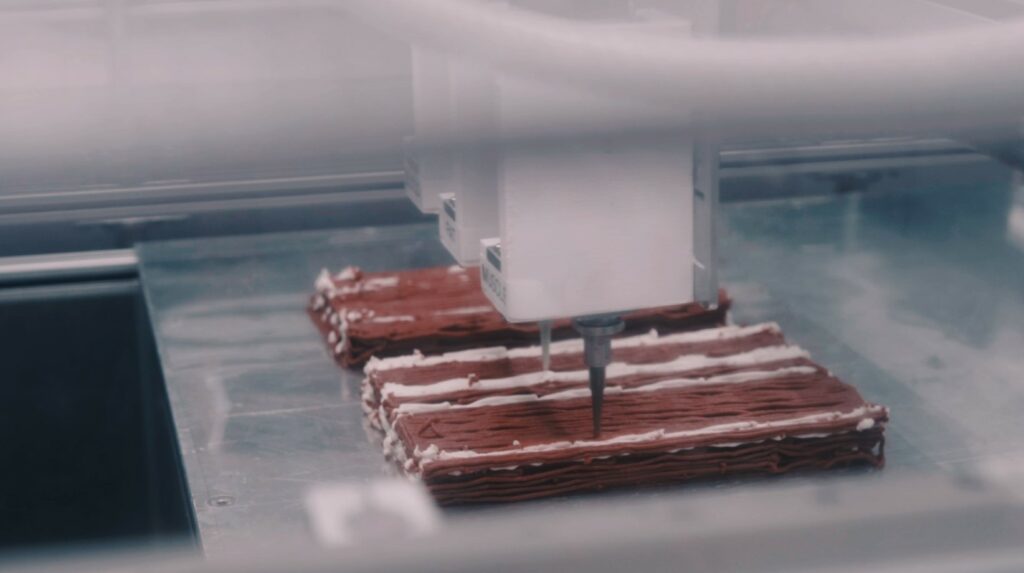3D meat printing is announcing a new era of food manufacturing. One where the final product is actually healthier and better for the environment than traditionally farmed animal products. The possibilities are huge, including food customization according to the need for specific nutrients and more.
Is 3D-Printed Meat “Real Meat”?
Traditional plant-based meat alternatives have been around for decades. However, most of them are an acquired taste, with very distinct textures than animal products. So far, none has been close to the feel of real meat.
The term 3D meat refers to a type of meat-similar product created using 3D printers. This new technology uses the help of artificial intelligence and material science to replicate the texture, nutritional composition and taste of animal meat. 3D printed meat may be vegetarian or not, according to the ingredients used into its production.
What is 3D-printed meat made of
While some labs culture meat based on stem cells from cows or chicken, the most popular use to print meat is to produce plant-based meat. Commonly, plant-based printed meat is produced using ingredients such as soy, pea protein, beetroot, chickpeas or other plant-based proteins and fats.
The process involves identifying the components that make good meat—muscle, blood and fat—and mimicking them with plant-based ingredients to achieve very similar results.
Why use a 3D printer? Printers offer the possibility of creating layers in a product, something that is not possible with extrusion and other traditional methods of manufacturing plant based products.
The layers replicate the muscle texture present in animal meat. You can have a layer of “meat”, followed by streaks of “fat”, just like in our favorite cut of meat.
What types of products can you find as 3D-Printed meat?
The technology of printing in 3D offers almost endless possibilities. The printer can be programmed to replicate almost any type of food. Thus, you can find 3D printed meats replicating beef, lamb and even pork.
The technology is relatively new, but there are already a number of brands producing alternative meats via 3D printing. Most common options available to consumers or restaurants include:
- Steaks
- Tenderloin
- Beef Flank
- Lamb Flank
- Pork chops
- Beef loin
and more.
3D-Printed Meat as an Environment-Friendly Alternative
Research from the Singapore University of Technology suggests that 3D printed food can address greenhouse gas emissions by replacing farmed meat, which is one of the main causes of environmental impact. Here are some ways printing 3D meat is beneficial for the environment:
- Reduces food waste: In traditional animal meat production, there is no shortage of food waste, from meat cuts and leftovers. Approximately 1.3 billion tons of food waste is generated every day. Printing the meat implies producing exactly what you need, without waste by-products.
- Is sustainable: traditional farming uses disproportionally large amounts of valuable resources such as land and water. By printing the meat in labs, companies can use less land, water and energy, producing more products with less resources.
- Reduces greenhouse gas emissions: the methane produced by farm animals has long been proven to be a key factor in greenhouse gas emission. By eliminating the need for farm animals, 3D printed meat effectively brings huge environmental benefits, reducing up to 95% the environmental impact.
Who eats these alternative printed meats?
With plant based products rising in popularity, even large fast food chains such as Mc Donald’s and Burger King jumped on the health wagon and are offering plant based alternatives to their patties-I was pleasantly surprised by finding plant based whoppers in Vienna-. But their offers usually lack the right “meaty” texture.
Vegans and vegetarians, although the obvious public for these types of products, are a minority in almost every market. Even in India, which has the largest percentage of vegetarians, it only amounts to 38%.
Interestingly, 3D printed alternative meats are targeted to meat eaters looking for a healthier alternative with all the taste.
But, Is 3-D Printed Meat Healthy?
Plant based products are naturally low in cholesterol and saturated fats, which makes them good meat replacements that prevent heart disease, regulate sugar levels and prevent strokes, among other benefits.
Additionally, one of the advantages of 3D printed meat is its potential for customization. Producers can customise and design their printed meat according to nutritional value, fat percentage and more.
When you combine both, you get a nutritionally healthy meat, that is low in fat, sodium and full of vitamins. This “meat” is designed specifically not only to replicate the texture and look of animal meat, but its nutritional value too.
The Take Away
3D printed food may seem something out of a Sci Fi movie, but it is real and can be the future of food. Sustainability, resource saving and reduction of emissions are some of the benefits of this technology. By printing alternative, plant based meats, organizations can help address climate concerns, and give their consumers healthier options.
